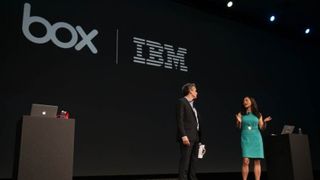How Box's shift to an enterprise 'content platform' is becoming a reality
A new UI for Box, fresh tools, big hook-ups with Google, IBM, and more…
New approach from Google
Even with all the new features, Box doesn't replace editing tools like Office, or even Office Online and Google Docs. Recently, Microsoft has begun to offer integration with cloud storage services like Box and Dropbox, not just from the Office applications and mobile apps, but also Office Online – if you have Office 365, you can control whether Box and Dropbox users in your company can open documents in the web versions of Word, PowerPoint and Excel. Google's move to open up Docs suggests that has made an impression.
The move to let Box work with Google Docs also follows the announcement last week that cloud identity service Okta will be Google's preferred identity provider for Google's largest customers (which will make it easier to use alongside other cloud services like Office 365 as well as Active Directory on premise).
That's a significant shift from Google's usual approach, which has been to create everything itself rather than partner with existing services. Google's Diane Greene hinted that it was a way to win customers the company would otherwise miss, and could then potentially interest in other Google services.
"We aren't going to build it all," she said in the Box keynote, suggesting that Google might partner on "anything around worker productivity where people offer services on the cloud", and even promised that Google wouldn't suddenly bring out its own versions of partner services. "We will never surprise you [with that]; if we're building it, you will know."

Relay race
Google isn't the only established player Box is working with – it's building its new workflow service, Relay, together with IBM. That's the second key area, Yeh told us. "We're moving into working with more large companies for true enterprise content management. For the very first time we have real workflow happening in Box, which has been a critical need."
"Think of Relay as a very simple document workflow product," he said. "Anyone in a company can create a very simple workflow to move documents back and forth through a series of approvals. We're trying to help the casual business user automate the processes they go through every day, sending documents back and forth in email. You can also extend it outside the organisation – that kind of external work is very common today, with contractors working across company borders."

You can create a workflow from scratch, or use a template. Add people to the workflow by typing in their email address and set dates for when things need to be done, and Relay will email and remind them. You can also look at all the workflows you're involved with and see what tasks are waiting for you to deal with.
Are you a pro? Subscribe to our newsletter
Sign up to the TechRadar Pro newsletter to get all the top news, opinion, features and guidance your business needs to succeed!
Dana Morris from IBM suggested that Relay might replace document workflows from Lotus Notes when it comes out in the first half of 2017. Relay won't be part of the standard Box service – both IBM and Box will sell it as an extra, although they wouldn't talk about pricing yet. For IBM, Relay replaces an existing workflow service on its Bluemix cloud that it has recently announced will be discontinued.
Importance of interconnection
Box is keen to make Relay work with more services, like Slack for example. The changes to make that kind of connection possible are Yeh's third area of focus. "There are a lot of changes in the underlying Box platform components," he told us. "In particular, the way Box looks at users is changing, because it's not just people that will be using the service – it's apps as well."
Today, Box has two kinds of users: managed users working at companies who use Box and external users who've been invited by a managed user to look at or collaborate on a file. "The volume of data coming into Box is higher than ever before," Yeh explained – there's around 700TB of data flowing in and out of the service every month. "Not all of that data needs to be assigned to specific users, so now we have a new type of user that's an app."
These kinds of changes under the hood are how Box plans to make the service interconnect with other tools, making it less about cloud storage and more about what CEO Aaron Levie calls a "modern content platform".
Mary (Twitter, Google+, website) started her career at Future Publishing, saw the AOL meltdown first hand the first time around when she ran the AOL UK computing channel, and she's been a freelance tech writer for over a decade. She's used every version of Windows and Office released, and every smartphone too, but she's still looking for the perfect tablet. Yes, she really does have USB earrings.











